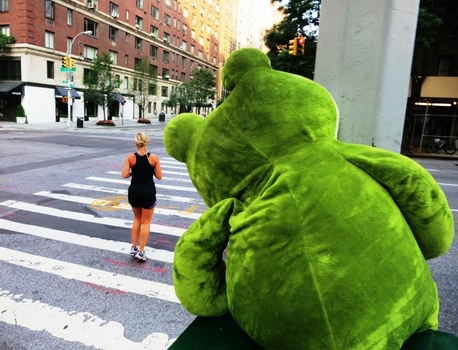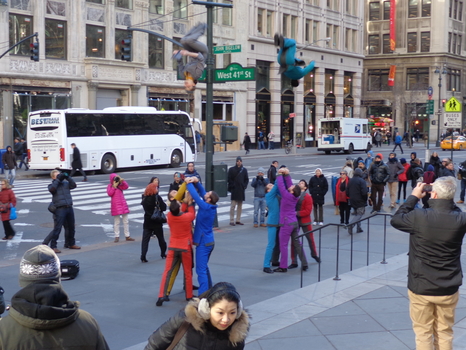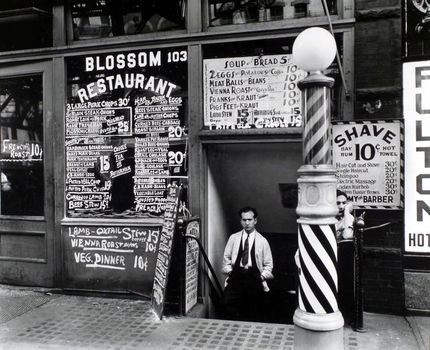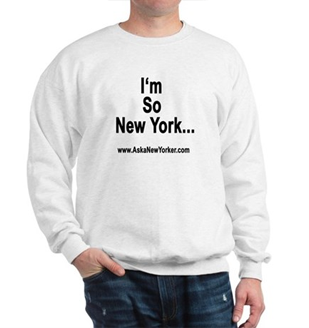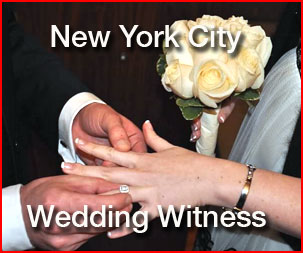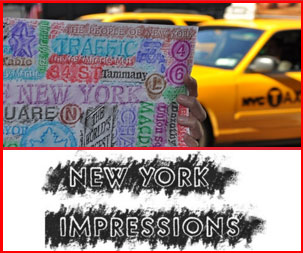We met Joyce on a crisp autumn afternoon in her fabulous apartment near Gramercy
Park. What a treat! Construction work in her apartment building was in progress,
so the keys were having difficulty opening the door due to all the dust. Finally
we got the door opened due to a kind man working in the building who jiggled
the keys just right to unlock the door.
Ask a New Yorker: We’re in! This is cool. We’re standing in the
ground floor rear….
Joyce: They’ve been putting a new marble floor in the public hall. So
you will have to excuse the dust that came through. The first thing you see
over the Jacuzzi is the mural I made, From Here to Eternity. There’s Deborah
Carr and Burt Lancaster on the beach. And every mural, I put both my daughter
and myself somewhere in it. We’re holding balloons in the back round on
the little boat.
Ask a New Yorker: What an entrance! What do we have over here on this wall?
Joyce: I’ve always wanted a hidden bedroom, and there’s a bedroom
behind that door. So you could not tell that I painted a mural of the old classic
on that wall, The Postman Always Rings Twice–the original with Lana Turner
and John Garfield where they’re on a beach.
Ask a New Yorker: What a stunning piece. The cigarette is glowing!
Joyce: I put something there to make it look that way. And all these women
in my murals end up with my jewelry.
We climb a circular stairwell to the second floor over looking the garden.
Joyce: This is one very big room and this was the original ballroom when the
building was built 176 years ago, so the ceiling is from then. I did the gold
painting of the fruit. But this time I had someone get up and do the greenish
metallic because I knew I would put this mural up, and there’s that color
film on the water. The mural is of Angelina Jolie on a rock at night. The moon
is cutting through with the glittering waves. This butterfly, when I turn on
a certain button, its wings go up and down so it looks like it’s fluttering.
This is a true tortoise shell.
Ask a New Yorker: Is Angelina aware that this wonderful piece exists?
Joyce: No, I just finished it. Maybe Brad would like it of her. This is my
work. I paint on canvas but the long, hard part of it are the things that I
add. I do it as I go along, as things come to me.
Ask a New Yorker: How would you describe your work? It’s impressionistic
yet surreal…It’s fun and unique…
Joyce: Most of my friends say, ‘that’s a “Joyceable’…because
no one else does that. It’s my type of three dimensional artwork. Now,
I do art work which is not three dimensional. What I do is fun, happy art and
it’s very unusual. I put this chandelier up in this room when I was in
a different faze of my life. So, before, I had three cords hanging down from
the ceiling with bulbs, one yellow, one red and one green. Also there were rugs
on the walls. And then I decided for a different look. I found this gorgeous
chandelier from Venice. It just finished everything up in here.
Ask a New Yorker: How long have you lived here on Gramercy Park?
Joyce: Over 25 years. When I moved here there was no balcony in this room.
I was not only the decorator but the architect as well.
Ask a New Yorker:(pointing to another piece) This is a fantastic Joycable!
A river boat with moving parts.
Joyce: Where I was raised in Ohio, there were lots of river boats. When you
turn it on, the paddle wheels move and the lights go on and off and I have every
movie star you can imagine there.
Ask a New Yorker: I see Jamie Lee Curtis…
Joyce: I have J-Lo, Liz Taylor, Nicole Kidman, That’s the only nude picture
that they know of, taken of Greta Garbo…here’s Bogie and Bacall
on their boat the Santana. Tony Curtis…and this beautiful backside is
Burt Lancaster. Also you can see Marilyn Monroe and Frank…
Ask a New Yorker: Where did you find the Indian head dress?
Joyce: I found this Indian head dress with all the history written down. It’s
from the Ziegfeld Follies in the 1920’s. So it’s not worn by an
Indian but made for the Follies.
Ask a New Yorker: And here is Madonna. Have you seen her in concert?
Joyce: Oh yes, I think she is wonderful. But I don’t know if everyone
knows this, but she is the largest private collector of Frida Kahlo art work.
As soon as she started making money she started collecting. So I’ve combined
her with Frieda Kahlo. I had a bracelet again of Frieda Kahlos enamels and I
cut it apart. I’m going to put white pleats all around her shoulder
Walking down the hallway Joyce recounts her first travels to Israel.
Joyce: I was sent to the Middle East to paint the leaders for a museum over
there. This is Rabin. He’s posing. He has his usual cigarette. And then
I painted the background down on the beach. I did this one of my daughter when
she was eight years old. And I added these words, “Happiness is knowing
that someone you love is beautiful inside”. Yesterdays have come and gone.
Today is slipping by. Tomorrow soon is yesterday. Let’s live before we
die.
Ask a New Yorker: Let’s revisit this time of your life later in our interview,
when you lived in Israel. But let me first ask you, “What’s your
earliest memory of being creative?”
Joyce: When I was just a little girl my parents gave me a blackboard to learn
to write and instead I started drawing. So I began drawing immediately. It was
there, it was in me. Then I came to New York when I was just a kid, seventeen
years old…. you know as I’m talking with you I realize how many
stories are connected with my art. I made a chair of Frank Sinatra where it
looks exactly like him sitting. In 1994 he was appearing at Radio City and he
was staying at The Waldorf and a friend of mine new him. I don’t know
how he had the time but he was on his way to Brooklyn and he had his car stop
here. And when he walked into my place he noticed all the celebrities I’ve
painted and said, “Ahh, there’s Burt, there’s Lana, there’s
Deborah”. These people were movie stars, who I’ve painted, but to
him they were his friends. He loved it! Then he saw the chair I had made of
him and he wanted it. But I wouldn’t give it to him. Because I wanted
it. (laughter) And I had the say. He was really wonderful and he signed it on
the collar. It reads, Frank Sinatra ’94.
Ask a New Yorker: Please continue with your stories. This is just wonderful.
Joyce: My Daddy, surprise, surprise in Ohio, owned movie theatres. So I sat
in movies morning, noon and night. To me the things that people said in the
movies sounded real. I used to wait for him to close up. I knew words and passages
from every movie. I could recite them. So when I came to New York, I wanted
to be an artist. I was an artist. I had no money. I moved into a room, just
a room where you had to sign a statement that you where an artist. Now, of course,
I would run. I would know something is so crazy. But I didn’t know. To
keep myself alive I got a job in a tie factory, and I was the only one who spoke
English. All the women were Puerto Rican. They were so kind. They would share
their sandwiches with me at lunch time. I was like ‘little girl’
lost in the city. But I new I wasn’t going to leave. I was here for a
reason. I hand painted day after day nudes on ties where they sold them on Broadway
for a few dollars. This is how I kept myself going. After I made enough to keep
going, I just kept going and my work got better and people kept recognizing
it. But I met a man and got married. Without going into anything, it did not
take. And I got divorced, but my lawyer was Louis Naizer, who many people have
heard of. He seemed to be very well known. I didn’t even know it when
I went to him. We became friends. He was a wonderful artist. One night he called
me and he said, “Joyce you’re going to Israel”. I had just
gotten my divorce. And I said; “Why would I go to Israel? If I leave the
states I would go to Paris or Switzerland”. I had no idea. I didn’t
know. Louis said he wanted me to speak with someone. The ambassador of Israel
had come in from Washington and they were at Mr. Naizer’s. They saw I
had done a portrait of him. In fact, this was the first time I did my unique
style of combining photography and oil painting. But when he gave me a painting,
I thought I would like to do some art for him. So I did a really lovely portrait
and he hung it up over his mantel. So the ambassador saw my work and sent me
over to paint the portraits of the leaders at that time. I painted portraits
for the Tel Aviv Museum and for The Israel defense Museum. I took my daughter,
who was very little, off on the biggest adventure of my life! It’s still
with me. I was there for 12 years. I did all the portraits, but it’s a
small country and I ran out of leaders. I came back to the states and ran into
a friend. A wonderful guy who was a producer, director at CBS. I had never been
a journalist. You must realize when you work in the arts and if you do someone’s
portrait, you sit and you get to know them. So my friend saw an opportunity
with all these leaders I had painted. These are the types of people that are
difficult to interview. My friend sent me back as a journalist, so I went with
credentials. They gave me a list of six people to interview. Well, I went over
to Israel, remember I had already had my foot in there because I had done portraits
and I came back with twenty eight interviews and two documentaries.
Ask a New Yorker: Don’t stop. This is better than any movie.
Joyce: Someone said to me, there’s a really interesting guy you should
interview–Ariel Sharon. I had seen him on TV. I had heard of him. He was not
prime minister at that time. But Ariel was always something in the government.
There was a time when he was like a thorn in their side because he had his own
way of doing things. I tried to set up an appointment. Three times he had to
cancel. By the time I got to his farm I knew he had a fabulous sense of humor
because we had spoken on the phone a lot with each time he cancelled. He had
a beautiful farm called Sycamore. He was waiting for me. He was so dynamic.
He is now in a coma, which happened over a year ago. After I interviewed him,
in front of me, he must of called seven different people, leaders, who I had
no plans of interviewing. He said “you’ve got to meet this guy,
you’ve got to meet this girl”. It’s the best interview I’ve
ever had. I’m very into people, if they’re nice, I really get into
it. When I interviewed Ariel on his farm he drove me all over. It was a working
farm where they were raising cotton. He said he wanted me to have something.
So he stopped his jeep and he pulled some cotton out and he gave it to me. You
saw the miniature house I made. That was Ariel’s farm house, but the cotton
was the cotton he had given me. And I wrapped it in burlap and put it next to
the barn.
Ask a New Yorker: Wow. What an amazing life you’re living! I really appreciate
your time spent today. Let’s see, one last question…..Joyce, with
all these wonderful experiences, what words would you give anyone starting out
trying to find their way in life?
Joyce: You can do anything if it means enough to you. You can do anything.
Just know what you want and go in that direction. You’ll get what you
want.
Ask a New Yorker: As Mick Jagger once sang…”You can’t always
get what you want, but you get what you need” ?


